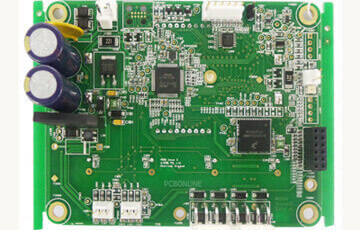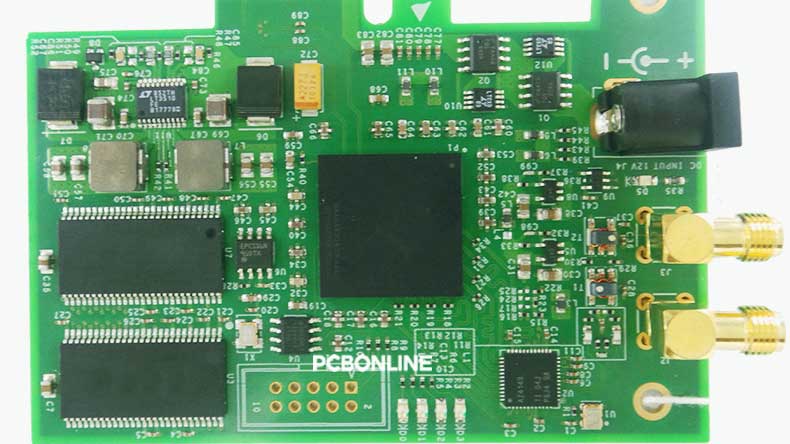
In this article, we bring to light surface mount devices comprehensively, including introducing various SMDs one by one, displaying their images so that you can identify them, SMD footprints, what package methods they are suitable for shipping, and an electronic component supplier and SMT assembly manufacturer.
What is SMD?
SMD is a surface mount device. They are electronic components mounted on printed circuit boards by the SMT method (surface mount technology).
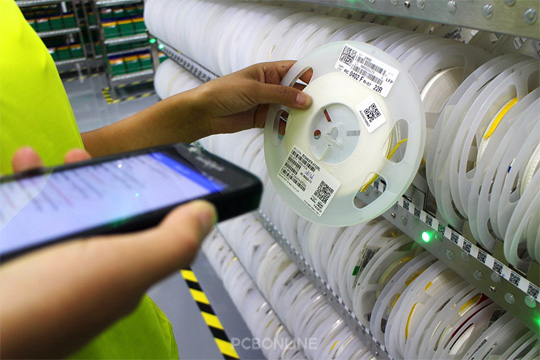
As an electronic engineer, PCB designer, or electronics hobbyist, you should know SMD, as SMT is the dominant PCB assembly technology in electronic manufacturing. When designing the PCB, you must choose SMDs with an appropriate footprint and place them in the correct orientation.
SMDs have very short pins or solder balls and are surface-mounted without PCB holes. They feature high-assembly-density, small weight, and size (about 1/10 of through-hole components in the same functions), PCB assembly automation, and precision in PCB assembly.
One-by-One Introduction to Various SMDs
All electronic components can be made as surface mount devices. It is impossible to list all the SMDs in an article, even a component online mall can't include all of them! But no worries. We introduce the main types of SMDs below!
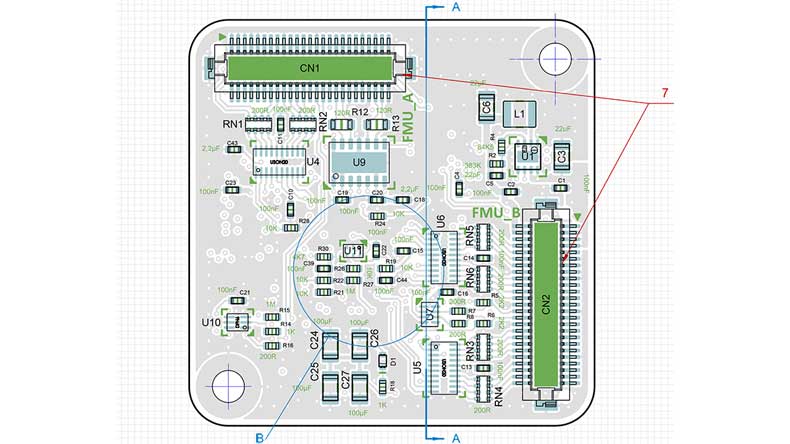
SMD resistor
Resistors limit electrical currents. All resistors are passive components and consumer energy into heat. The units of resistors are Ω, KΩ, and MΩ. Ω is ohm. The symbol of resistors is R.
Here are the common SMD resistors.

Note: Among the above SMD resistors, the first two are ordinary resistors, the third and fourth are shunt resistors, the fifth are wirewound resistors, and the last one is a metal film resistor.
SMD capacitor
Capacitors or condensers store electrical energy in an electric field. In electronic circuits, they block direct current and allow alternating current to flow through them. The units of capacitors are F, μF, nF, and pF. F is farad. The symbol of capacitors is C.
The common SMD capacitors include:

Note: Among the above SMD capacitors, the first is a ceramic capacitor, the second is a tantalum capacitor, the third is an aluminum electrolytic capacitor, and the last two are orange tantalum capacitors (orange marks the positive electrode).
SMD inductor
Inductors convert electrical energy into magnetic energy and store it. When alternating current flows through the inductor coil, the magnetic lines inside the coil will change with the alternating current, causing the coil to produce electromagnetic induction. The units of inductors include H, mH, μH, and nH. H is Henry. The symbol of inductors is L.
Common SMD inductors are:

Note: Among the above SMD inductors, the first three are inductor coils, the fourth and sixth are coils, and the fifth is a choke coil.
SMD diode
A diode allows current to flow in only one direction, commonly used to convert alternating current to direct current. It is a semiconductor device composed of a P-N structure. According to the function, there are switching diodes, light-emitting diodes, and zener diodes. The symbol of diodes is D.
You can see common SMD diodes below.

Note: Among the above SMD diodes, the first two are ordinary diodes, the third and fourth are two-terminal diodes, the fifth and sixth are light-emitting diodes (LEDs), and the last one is a special-shaped LED.
SMD transistor
Transistors amplify current. A transistor is a semiconductor device composed of two P-N junctions that separate the device into three parts - the base in the middle, the emitter and collector on the two sides. The symbol of transistors is Q.
Common SMD transistors are below.

Note: Among these SMD transistors, the last one is a phototransistor.
SMD IC
IC is an integrated circuit. There are many different packages of ICs, including SOP, QFP, SOJ, PLCC, BGA, CSP, etc. The symbol of ICs is U.
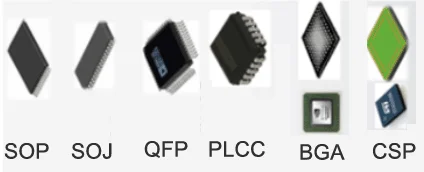
SOP is a small outline package. It has pins that spread out on its two sides.
QFP is a quad-flat package. It has pins that spread out on the four sides.
SOJ is a small outline J-lead package. It has pins on the two sides. The pins are bent toward the bottom of the SMD IC, forming a J shape.
PLCC is a plastic-leaded chip carrier. It has pins on the four sides. The pins are bent toward the bottom of the IC.
BGA is a ball grid array. It has solder balls in a grid array at the bottom of the IC.
CSP is a chip scale package. It has solder balls in a grid array at the bottom of the IC. Its mounting area required for the package is very close to the chip size.
SMD crystal oscillator
Crystal oscillator, also called quartz crystal, is the general term for quartz crystal oscillator (active crystal oscillator) and quartz crystal resonator (passive crystal oscillator). In digital circuits, a crystal oscillator provides base frequency and basic clock signals for the system. The symbols of crystal oscillators are X and Y.
You can see SMD crystal oscillators below.

Note: Except for the penultimate one, which is an SMD quartz oscillator, the others are SMD crystal oscillators.
There are still many SMDs that haven't been introduced! I only list their names and display their images here.
SMD resistor bank, symbol RB

SMD switch, symbol S

SMD magnetic bead, symbol FB

SMD transformer, symbol T

etc.
There are millions of types and models of SMDs. If you want to receive one-on-one assistance in SMD and PCB layout, just feel free to ask the professionals at PCBONLINE by chatting from the online chat window on the page!
And wait, if you want to read the values and orientation on the SMDs, we previously published two blogs, "How to Identify SMD Components from Appearances" and "SMD Polarity Identification of LED, Capacitor, Diode, Inductor, IC", which may help you.
SMD Footprint
Footprint is the outline of an SMD and through-hole component on a printed circuit board. It is the 1:1 projection of an electronic component on the PCB.
In a PCB component library, the pins of an SMD are in red, which means they are in the top layer of the PCB.
For example, you can see the SMD LQFP-48 and its footprint. LQFP-48 has 4 sides, each with 12 pins, and a total PIN of 48.
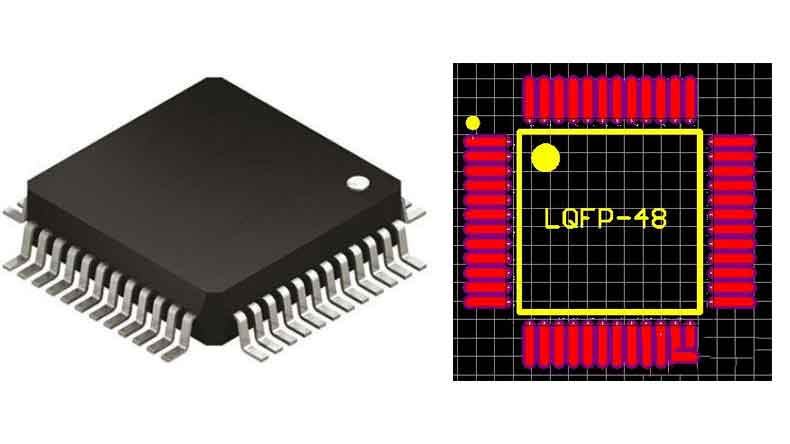
Below are two tables. One is the common SMD footprints. The other is the tantalum capacitors' footprints.
Common SMD Footprint
|
SMD footprint (imperial) |
SMD footprint (metric) |
Size (mm) |
|
01005
|
0402
|
0.4 x 0.2
|
|
0201
|
0603
|
0.6 x 0.3
|
|
0402
|
1005
|
1.0 x 0.8
|
|
0603
|
1608
|
1.6 x 0.8
|
|
0805
|
2125
|
2.0 x 1.25
|
|
1206
|
3216
|
3.2 x 1.6
|
|
1210
|
3225
|
3.2 x 2.5
|
Common SMD tantalum capacitor footprint
|
Footprint |
Metric footprint |
Size (mm) |
|
A
|
3216
|
3.2 x 1.6 |
|
B
|
3528
|
3.5 x 2.8
|
|
C
|
6032
|
6.0 x 3.2
|
|
D
|
7343
|
7.3 x 4.3
|
|
E
|
7845
|
7.8 x 4.5
|
Package methods of SMD
For shipping and SMT assembly, SMDs are packaged in tapes/reels, trays, and tubes.
Tape/reel
Tape/reel is the most common package method for SMDs. About 90% of SMDs are packaged in this way because all SMT mounting machines are compatible with tape and reels.
Tray
For some SMDs with a bigger footprint, trays provide enough accommodation space. Especially, for the ICs in the package of QFP, TQFP, and BGA with 48 or more pins, packaging them in a tray is the most appropriate method to ship them safely.
Tube
If there are many types of SMDs in a small quantity, they can be packaged in tubes (100 to 200 SMDs in the same direction in a tube).
Before SMT PCB assembly, SMDs are transferred from tubes to trays so that they can be sucked by the nozzle of the SMD mounting machine.
How are SMDs soldered on the PCB?
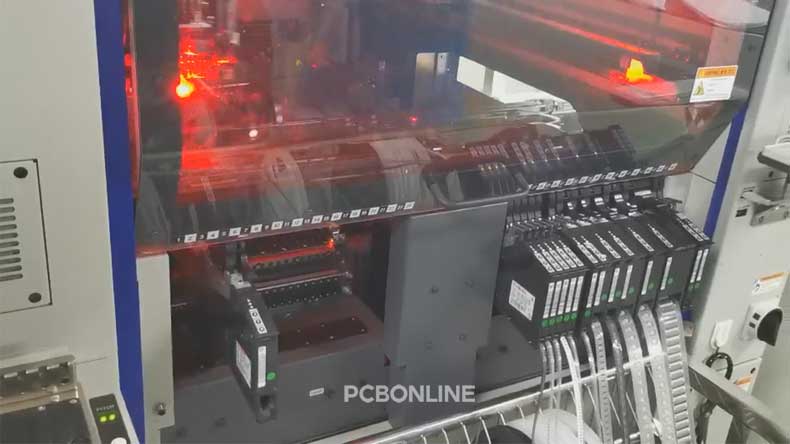
During SMT assembly, SMDs in tapes or trays are installed in the feeder that supplies the SMDs to the high-speed and functional component mounting machines. The SMDs are sucked by the SMT placement head of the component mounting machine to place on the PCB.
In reflow soldering, the solder, PCB copper pads, and SMD contact side form an intermetallic compound. It is a highly reliable connection and marks the success of SMD soldering.
SMD Supplier and SMT Assembly Manufacturer for You
Hey! Now you've got a very complete insight into SMDs and SMD soldering. I wonder if you are looking for a reliable and quick-turn SMD supplier and SMT assembly manufacturer, where you can buy plenty of types of components and assemble them into PCBA or modules.

PCBONLINE is a one-stop SMD supplier and PCBA manufacturer. It has an electronic component warehouse that stores more than 100,000 types of SMDs and through-hole components, two large advanced PCB manufacturing bases, and one PCB assembly factory for electronic manufacturing and PCBA box-build assembly.
You can see part of the SMD zone of the component warehouse at PCBONLINE. The ICs are stored in cabinets in a specialized room, which is accessible by a dedicated person.
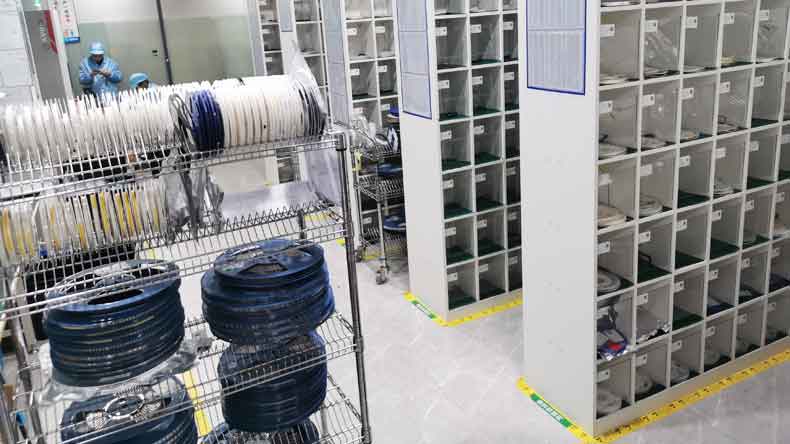
PCBONLINE makes it affordable for you to buy SMDs because it can -
PCBONLINE has hundreds of supply chains around the world and can find out the most affordable SMDs through regional price differences.
Relying on its EMS PCB assembly factory, it can take part in co-procurement with other large EMS from the original component factories with discounts.
PCBONLINE can integrate different BOMs of different customers to source components at a larger quantity and lower the unit price.
Besides, PCBONLINE has cooperation with local component factories that produce affordable custom-made/special-shaped components.
You can buy SMD components and have printed circuit boards assembled with components from PCBONLINE. You can watch the PCB assembly video of PCBONLINE and learn how SMDs are soldered.
The electronic boards made by PCBONLINE are certified with ISO 9001:2015, 9001:2016, IATF 16949, RoHS, REACH, UL, and IPC. All the SMDs and PCBAs are traceable. If you want to get a quote for SMDs, PCBs, PCBAs, or box-build assembly, you can contact info@pcbonline.com through emails.
Conclusion
After reading this article, you now have a comprehensive understanding of surface-mounted devices, including various SMD types, seeing their images, SMD footprints, package methods, and SMD soldering. If you to learn more about SMDs, the related articles below may be helpful.
PCB assembly at PCBONLINE.pdf



